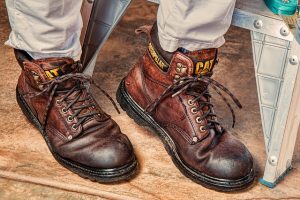 Construction sites are some of the most dangerous worksites in the United States. Workers can be injured from falls, run overs, loose debris, fires, cave ins, repetitive motions, electrical shocks and other causes. If you supervise construction sites, safety rules are imperative. Achieve a safe environment and minimize risks when you prioritize safety, train your employees and follow construction workplace safety rules.
Construction sites are some of the most dangerous worksites in the United States. Workers can be injured from falls, run overs, loose debris, fires, cave ins, repetitive motions, electrical shocks and other causes. If you supervise construction sites, safety rules are imperative. Achieve a safe environment and minimize risks when you prioritize safety, train your employees and follow construction workplace safety rules.
Wear Protective Equipment
The Federal Occupational Safety and Health Act (OSHA) mandates certain safety rules for the workplace. Protective equipment is included in OSHA rules, and all construction workers must be given access to and use the right clothing and equipment for their duties. Examples include hard hats, gloves, safety boots, coveralls, goggles, safety masks and protection harnesses. Lab coats, paper face masks and plastic gloves may be required, too, depending on the job.
Pay Attention to Height
OSHA regulations require different rules for work that’s done at different heights. Constriction site supervisors should know the rules and perform an on-site risk assessment, planning, organization and supervision to make sure they’re implemented.
In general, anyone who works at high elevations must be protected from falling any distance that will cause an injury. Scaffolds with a double guard rail can be used to meet this rule. Another safety guideline requires equipment to be in place that reduces the distance and impact of any falls that do occur. Harnesses and safety nets can meet this construction site requirement.
Provide Amenities
Several amenities are required on construction worksites. First, construction workers must have access to a steady supply of clean water and the proper first aid equipment.
Construction sites must also provide workers with a sheltered space where they can take breaks and enjoy meals. That break room has to be hygienic and pose no safety or health risks. If more than 15 workers are at the site, it also must have space for them to sit down, wash dishes, boil water and store food and utensils.
All sites must provide toilet access, too. It has to be private in a cubicle or room with a door, and ventilation and toilet paper are required.
Keep your workers safe and comply with OSHA regulations when you implement these safety rules on your construction sites. Train your employees and independent contractors to follow the rules and prioritize safety, too. You have adequate Workers’ Compensation insurance, but work together to prevent accidents and promote a hazard-free worksite that’s efficient and productive.





